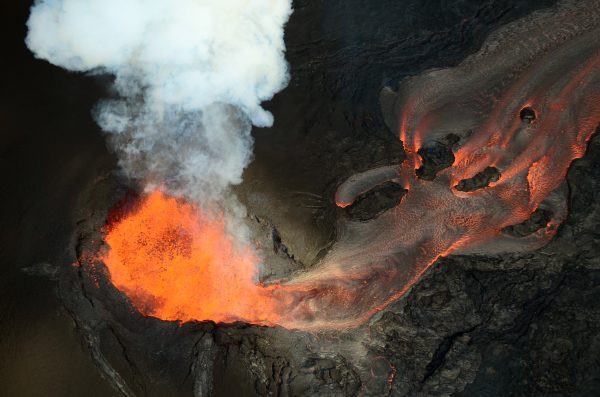
Kilauea Volcano provides hot research opportunities
Though Kilauea Volcano is more than 3,000 miles away, researchers at the University of Alaska Fairbanks are helping study the ongoing eruptions there.
“When there is a big eruption crisis like this, the (U.S. Geological Survey) pulls their own people from all sorts of different volcano observatories,” geophysics professor Jeff Freymueller said. “A number of our colleagues from the USGS here in Alaska have been sent to Hawaii to help out.”
If there was a similar crisis in Alaska, USGS staff from Hawaii would be here to help respond, Freymueller said. “These crises tend to completely overwhelm the staff at any one place, so that’s part of the way that it gets managed.”
In addition to USGS volcanologists who work at the Alaska Volcano Observatory, other researchers at UAF’s Geophysical Institute helped out in a variety of ways.
Ash analysis
When Kilauea became more active in May, GI petrologist Jessica Larsen called Tina Neal, the scientist in charge of the Hawaii Volcano Observatory, to ask if there was some way Larsen and her Alaska colleagues could help.
Neal sent ash samples from the eruption. Larsen, petrologist Pavel Izbekov, and their graduate students Nathan Graham and Valerie Wasser began their analysis. The Hawaii Volcano Observatory team wanted to know how much volcanic glass was in the ash and where it was from, among other analyses.
“The glass could come from the lava inside the lava lake, or from the rocks along the walls of the lava lake,” Larsen said. Determining how much glass is in the ash reveals information about the magma.
Their analyses of the sample reported quantities of glass, mineral crystals and broken rock fragments.
“That will help them figure out what exactly is going on with the explosions, whether there’s some fresh new magma and lava involved or whether it’s just a steam explosion blowing out existing rock,” Larsen said.
Nathan Graham, a graduate student who works with Larsen, used a scanning electron microscope to inspect the ash.
“Most of what we found looked like old wall rock that was broken up, but we definitely found some nice glass that looked like it may be juvenile material,” Graham said.
Performing these kinds of rapid analyses of ash is something staff members at AVO do often, Larsen said.
“It’s exciting that we can be a part of the Kilauea response, albeit remotely. We’re not involved in the day-to-day response, but we’re providing support through these analyses,” Larsen said.
Tracking magma with radar
Xueming Xue, a graduate student working with Freymueller, has been using interferometric synthetic-aperture radar, or INSAR, to measure ground deformation — the rising, lowering or shifting of the ground surface as a result of volcanic activity below.
“Imagine that you had a balloon underneath a pile of sand and then you let the air out of the balloon. What would happen?” Freymueller said. “Things would collapse. As the pressure decreases as the magma leaves, the ground actually moves inward and downward.”
Xue’s research will characterize how the pressure in the magmatic system is changing over time — which also will show how the magma has moved.
These data can be used to see how far down the rift the magma goes and when it arrived there, Freymueller said. Also, the data can help predict when eruptions might end. If the volcano erupts, the magma spills out and the pressure underneath the ground decreases. However, if the magma supply keeps coming, then the ground wouldn’t deflate — it could even continue to inflate.
“The next question that people will ask is ‘when will this stop?’ We don’t really know, but as long as there is a continuous supply of magma, there’s really no reason for it to stop,” Freymueller said. “It’ll stop when that supply gets cut off and the pressure equalizes.”
Volcanic infrasound
Volcanoes produce infrasound waves that are too low in frequency for humans to hear — below about 20 hertz. For comparison, the deep rumble of thunder is between 20 and 120 hertz, and the sound of someone’s voice over the telephone spans about 300 to 3,400 hertz.
Specialized microphones are used to record infrasound. Researchers can then use the sound waves to learn things that can be difficult to measure directly, like how much material is coming out of a volcano.
AVO volcanologist David Fee sent portable infrasound equipment to Hawaii to pick up higher-quality data from Kilauea. That equipment now forms one of multiple infrasound arrays on Kilauea.
“They’re using (infrasound) to help detect when a new fissure opens, becomes more vigorous, or if it starts to move,” he said. “These fissures produce infrasound. As the gas comes out it sounds like a jet engine. The explosions at Kilauea summit are also producing some really interesting infrasound signals.”
An abundance of data
Other GI researchers analyze other data from the volcano and send their findings back to Hawaii.
“I’ve been looking at satellite sulfur dioxide masses to see temporal changes,” AVO volcanologist Taryn Lopez said. Because volcanic gases are a component of magma, changes in the gas flux over time can indicate changes in the magma supply.
Lopez’s work in Alaska was recently postponed so she can travel to Hawaii in July to help collect ground-based data, since the Hawaii observatory will be short-staffed at that time.
“This is likely a once-in-a-generation eruption for volcanologists — not just U.S. volcanologists but everywhere,” Fee said. “It is in a populated area, it is a major eruption, there’s a significant societal impact, and Kilauea is an incredibly well-monitored volcano. For years people will be looking at these data.”
Sue Mitchell, University of Alaska Fairbanks Geophysical Institute, 907-474-5823, sue.mitchell@alaska.edu
Jeff Freymueller, University of Alaska Fairbanks Geophysical Institute, 907-474-7286, jfreymueller@alaska.edu
David Fee, University of Alaska Fairbanks Geophysical Institute, 907-474-7564, dfee1@alaska.edu
Jessica Larsen, University of Alaska Fairbanks Geophysical Institute, 907-474-7992, jflarsen@alaska.edu
Taryn Lopez, University of Alaska Fairbanks Geophysical Institute, 907-474-7389, tmlopez@alaska.edu





